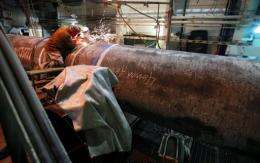First North Stream gas pipeline completed: consortium

The first of two North Stream gas pipelines, due to pump gas from Russia to Germany by way of the Baltic Sea, bypassing eastern Europe, has been completed, the consortium building it announced on Thursday.
The 1,224-kilometre (760-mile) undersea pipeline is due to start pumping gas by the end of the year, the consortium said in a statement.
"Europe will soon have the security of the privately financed, 7.4 billion euros ($10.9 billion) North Stream project providing a fixed link between the European gas grid and some of the world’s largest gas reserves in Russia for at least 50 years," North Stream’s managing director Matthias Warnig.
In 2012, when the second pipeline has been completed, Russia will be able to pump 55 billion cubic metres (1.9 billion cubic feet) of gas per year to consumers in western Europe, enough to supply 26 million homes, according to North Stream.
The consortium is a joint venture between the Russian energy giant Gazprom, the German firms BASF and E.ON, the Dutch firm Nederlandse Gasunie and the French GDP Suez.
Gazprom controls one-fourth of the world's gas reserves and is responsible for about eight percent of Russia's gross domestic product. It provides a quarter of all the gas consumed by Europe.
North Stream links the Russian city of Vyborg and Greifswald in Germany, running through Russian, Finnish, Swedish, Danish and German waters.
The pipeline has been laid out in three sections which must still be connected before pressure tests are carried out over the summer.
"In July the gas will be put into the pipeline and in October-November our European customers will get gas," Russian Prime Minister Vladimir Putin said in April in Denmark.
It is hoped that the pipeline will avoid a repetition of supply problems in recent years when bilateral rows, notably between Russia and Ukraine, affected delivery of Russian gas to Europe.
Poland and the Baltic states have long expressed concern over the project, fearing they will be left alone when bargaining with Russia for their own overland gas deliveries. Critics claim the Kremlin uses its energy clout as a strategic tool.
Gazprom is also involved in a second gas pipeline project -- South Stream due to link southern Russia to southern Europe by way of a link under the Black Sea.
This project, which also involves Italy's ENI energy group, has recently been joined by the German BASF subsidiary already involved in North Stream. France's EDF electricity group is also expected to join later this year.
South Stream, which is not expected to see the light before late 2015, must however still receive a green light from Turkey which is itself involved in another gas pipeline project -- Nabucco -- backed by the European Union and the United States.
The path Nabucco is supposed to take, from the Caspian Sea via Turkey and eastern Europe, bypasses both Russia and Ukraine.
This project however has so far failed to sign up any producer countries in central Asia, and EU officials have suggested Moscow is putting pressure on them not to sign up.
(c) 2011 AFP















